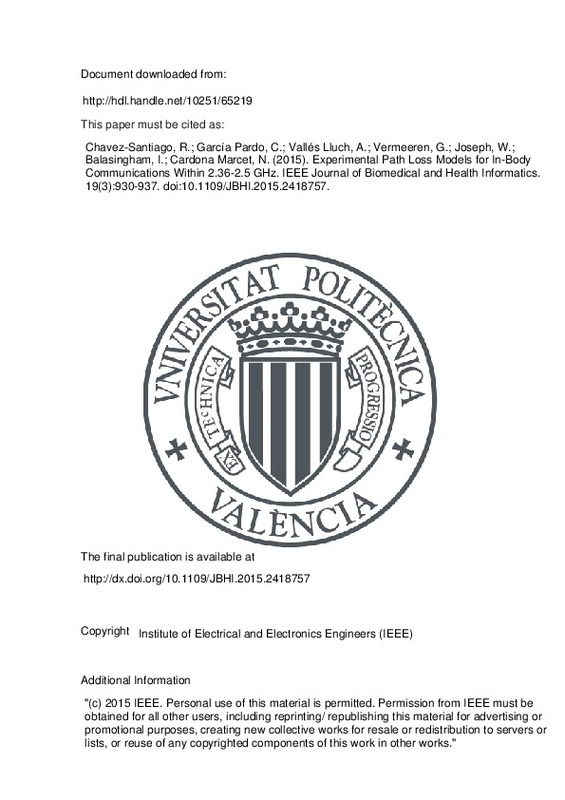JavaScript is disabled for your browser. Some features of this site may not work without it.
Buscar en RiuNet
Listar
Mi cuenta
Estadísticas
Ayuda RiuNet
Admin. UPV
Experimental Path Loss Models for In-Body Communications Within 2.36-2.5 GHz
Mostrar el registro sencillo del ítem
Ficheros en el ítem
| dc.contributor.author | Chavez-Santiago, Raul
|
es_ES |
| dc.contributor.author | García Pardo, Concepción
|
es_ES |
| dc.contributor.author | Fornés Leal, Alejandro
|
es_ES |
| dc.contributor.author | Vallés Lluch, Ana
|
es_ES |
| dc.contributor.author | Vermeeren, Guenter
|
es_ES |
| dc.contributor.author | Joseph, Wout
|
es_ES |
| dc.contributor.author | Balasingham, Ilangko
|
es_ES |
| dc.contributor.author | Cardona Marcet, Narciso
|
|
| dc.date.accessioned | 2016-06-03T12:10:52Z | |
| dc.date.available | 2016-06-03T12:10:52Z | |
| dc.date.issued | 2015-05 | |
| dc.identifier.issn | 2168-2194 | |
| dc.identifier.uri | http://hdl.handle.net/10251/65219 | |
| dc.description | "(c) 2015 IEEE. Personal use of this material is permitted. Permission from IEEE must be obtained for all other users, including reprinting/ republishing this material for advertising or promotional purposes, creating new collective works for resale or redistribution to servers or lists, or reuse of any copyrighted components of this work in other works." | es_ES |
| dc.description.abstract | Biomedical implantable sensors transmitting a variety of physiological signals have been proven very useful in the management of chronic diseases. Currently, the vast majority of these in-body wireless sensors communicate in frequencies below 1 GHz. Although the radio propagation losses through biological tissues may be lower in such frequencies, e.g., the medical implant communication services band of 402 to 405 MHz, the maximal channel bandwidths allowed therein constrain the implantable devices to low data rate transmissions. Novel and more sophisticated wireless in-body sensors and actuators may require higher data rate communication interfaces. Therefore, the radio spectrum above 1 GHz for the use of wearable medical sensing applications should be considered for in-body applications too. Wider channel bandwidths and smaller antenna sizes may be obtained in frequency bands above 1 GHz at the expense of larger propagation losses. Therefore, in this paper, we present a phantom-based radio propagation study for the frequency bands of 2360 to 2400 MHz, which has been set aside for wearable body area network nodes, and the industrial, scientific, medical band of 2400 to 2483.5 MHz. Three different channel scenarios were considered for the propagation measurements: in-body to in-body, in-body to on-body, and in-body to off-body.We provide for the first time path loss formulas for all these cases. | es_ES |
| dc.language | Inglés | es_ES |
| dc.publisher | Institute of Electrical and Electronics Engineers (IEEE) | es_ES |
| dc.relation.ispartof | IEEE Journal of Biomedical and Health Informatics | es_ES |
| dc.rights | Reserva de todos los derechos | es_ES |
| dc.subject | Body area network (BAN) | es_ES |
| dc.subject | implantable | es_ES |
| dc.subject | in-body | es_ES |
| dc.subject | path loss (PL) | es_ES |
| dc.subject | propagation | es_ES |
| dc.subject.classification | MAQUINAS Y MOTORES TERMICOS | es_ES |
| dc.subject.classification | TEORIA DE LA SEÑAL Y COMUNICACIONES | es_ES |
| dc.title | Experimental Path Loss Models for In-Body Communications Within 2.36-2.5 GHz | es_ES |
| dc.type | Artículo | es_ES |
| dc.identifier.doi | 10.1109/JBHI.2015.2418757 | |
| dc.rights.accessRights | Abierto | es_ES |
| dc.contributor.affiliation | Universitat Politècnica de València. Instituto Universitario de Telecomunicación y Aplicaciones Multimedia - Institut Universitari de Telecomunicacions i Aplicacions Multimèdia | es_ES |
| dc.contributor.affiliation | Universitat Politècnica de València. Departamento de Termodinámica Aplicada - Departament de Termodinàmica Aplicada | es_ES |
| dc.contributor.affiliation | Universitat Politècnica de València. Departamento de Comunicaciones - Departament de Comunicacions | es_ES |
| dc.contributor.affiliation | Universitat Politècnica de València. Centro de Biomateriales e Ingeniería Tisular - Centre de Biomaterials i Enginyeria Tissular | es_ES |
| dc.description.bibliographicCitation | Chavez-Santiago, R.; García Pardo, C.; Fornés Leal, A.; Vallés Lluch, A.; Vermeeren, G.; Joseph, W.; Balasingham, I.... (2015). Experimental Path Loss Models for In-Body Communications Within 2.36-2.5 GHz. IEEE Journal of Biomedical and Health Informatics. 19(3):930-937. doi:10.1109/JBHI.2015.2418757 | es_ES |
| dc.description.accrualMethod | S | es_ES |
| dc.relation.publisherversion | http://dx.doi.org/10.1109/JBHI.2015.2418757 | es_ES |
| dc.description.upvformatpinicio | 930 | es_ES |
| dc.description.upvformatpfin | 937 | es_ES |
| dc.type.version | info:eu-repo/semantics/publishedVersion | es_ES |
| dc.description.volume | 19 | es_ES |
| dc.description.issue | 3 | es_ES |
| dc.relation.senia | 302688 | es_ES |







![[Cerrado]](/themes/UPV/images/candado.png)

